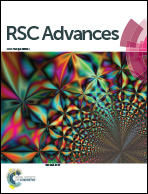Three-dimensional porous nickel supported Sn–O–C composite thin film as anode material for lithium-ion batteries
Abstract
A three-dimensional porous nickel supported Sn–O–C composite thin film anode is fabricated by the galvanostatical electrodeposition of an active material, Sn, onto a patterned three-dimensional porous nickel current collector from an organic electrolyte. The unique structure enables the homogeneous coating of Sn–O–C composite thin film, 100 nm in thickness, on highly porous dendritic Ni particles. Along with the existence of inter-particle spacings, this could efficiently accommodate great volume changes caused by the lithiation and delithiation of active material, Sn. The morphology, crystalline structure and chemical composition of Sn–O–C composite are characterized by field emission scanning electron microscopy (FESEM), X-ray diffraction (XRD), X-ray photoelectron spectroscopy (XPS) and transmission electron microscopy with an energy dispersive X-ray analyzer (TEM-EDX), respectively. The results demonstrate that the Sn–O–C composite is composed of agglomerated Sn nanocrystals, which are inhomogeneously distributed in the decomposition products of organic electrolyte. Moreover, the electrochemical behavior of the Sn–O–C composite anode is investigated by cyclic voltammetry (CV), galvanostatic charge/discharge tests and electrochemical impedance spectroscopy (EIS). This anode delivers a discharge capacity of 573.4 mA h (g of Sn)−1, (0.0883 mA h cm−2) after 100 cycles at 0.2 C-rate. The augmentation in total SEI and interfacial charge transfer impedance adequately explained the gradual capacity fading as cycle number increases.


 Please wait while we load your content...
Please wait while we load your content...